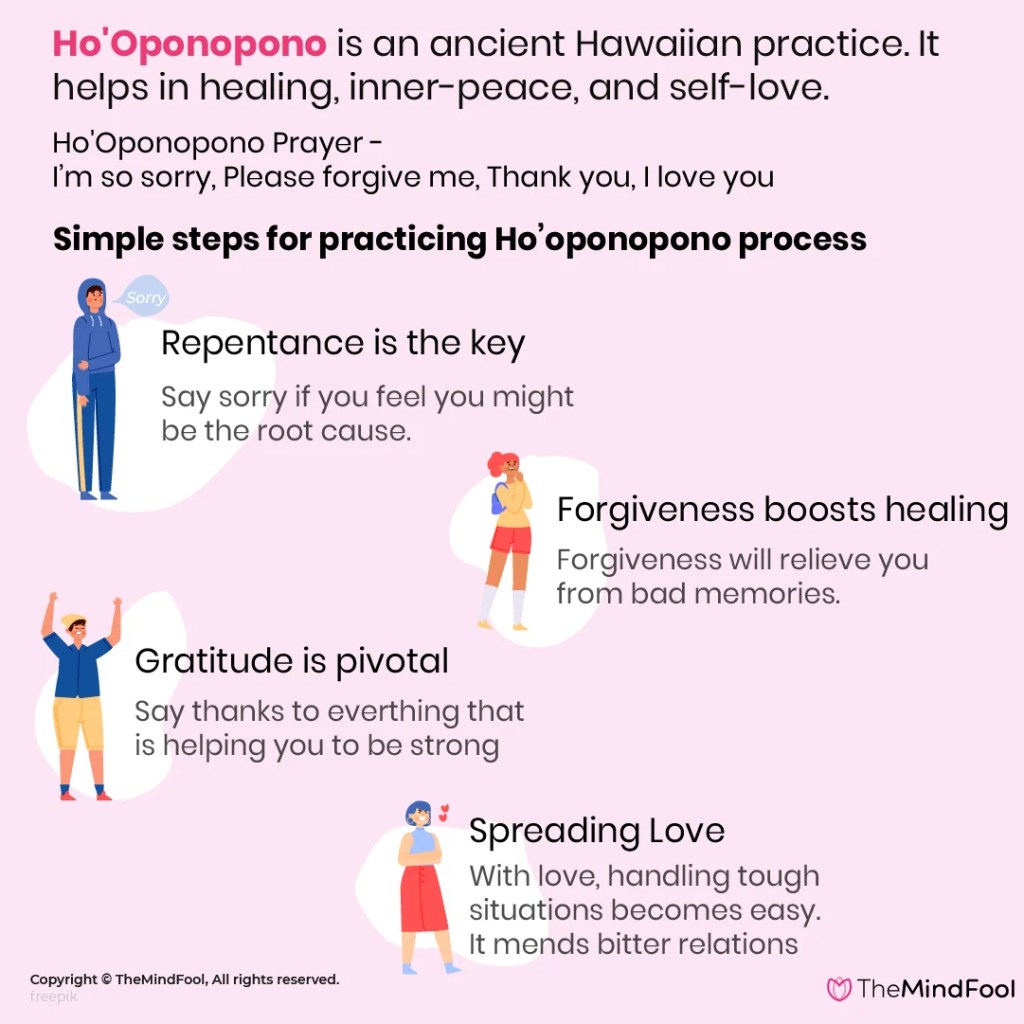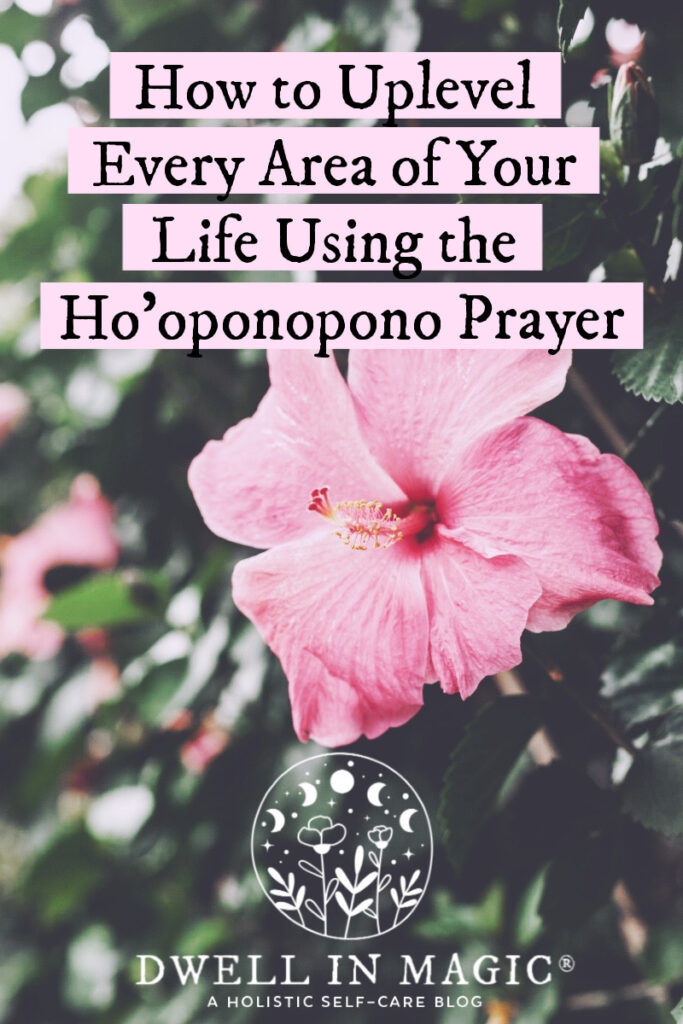In this article, you will learn about the core steps involved in practicing Ho’oponopono. Ho’oponopono is a traditional Hawaiian practice of forgiveness and reconciliation that is used to heal past wounds and restore balance. By understanding and implementing these steps, you can begin to release negativity, let go of resentment, and find inner peace.
The first step in practicing Ho’oponopono is taking full responsibility for your own experiences and emotions. This means acknowledging that everything in your life is a reflection of your own thoughts and beliefs. The second step is expressing gratitude and saying the four key phrases of Ho’oponopono: “I’m sorry, please forgive me, thank you, I love you.” These phrases are a way of acknowledging and healing the wounds within yourself and others. The third step is letting go and surrendering to a higher power or the Universe. This involves releasing your attachment to outcomes and trusting that everything will unfold as it should. By following these steps, you can begin to experience the transformative power of Ho’oponopono in your life.

Understanding Ho’oponopono
Ho’oponopono is an ancient Hawaiian practice that focuses on forgiveness, reconciliation, and the restoration of harmony within oneself and with others. By taking responsibility for our actions, letting go of attachments, and cleaning our thoughts and emotions, we can connect with the divine and experience healing and transformation. In this article, we will explore the core steps involved in practicing Ho’oponopono and the benefits it can bring to our lives.
Origin and meaning of Ho’oponopono
Ho’oponopono originated in Hawaii and has been practiced for centuries as a way to resolve conflicts, heal relationships, and restore balance. The word “Ho’oponopono” can be broken down into two parts: “ho’o,” which means to make, and “ponopono,” which means right. Together, they signify making things right or setting things in order.
The practice of Ho’oponopono traditionally involved a gathering of family members or community members, where a facilitator would guide them through a process of introspection, forgiveness, and reconciliation. Today, Ho’oponopono can be practiced individually, as a way to heal oneself and cultivate inner peace.
Key principles and beliefs of Ho’oponopono
Ho’oponopono is rooted in several key principles and beliefs that shape its practice:
-
Taking Responsibility: Ho’oponopono emphasizes personal responsibility for our thoughts, actions, and experiences. It teaches that we have the power to change our reality by taking ownership of our emotions and responses.
-
Acceptance and Letting Go: Central to Ho’oponopono is the idea of accepting and letting go of past experiences, attachments, and resistance. By releasing what no longer serves us, we create space for healing and transformation.
-
Cleaning and Clearing: Ho’oponopono involves cleaning and clearing our subconscious mind from negative emotions, thoughts, and beliefs. This process allows us to shift our perspective and cultivate a positive mindset.
-
Connecting with Divinity: Ho’oponopono acknowledges the presence of a higher power or divine intelligence. By establishing a connection with this higher power, we can seek guidance, support, and wisdom in our journey of healing and self-discovery.
-
Releasing and Healing: Ho’oponopono focuses on releasing energetic blocks and limitations that hinder our growth and well-being. Through this process, we can experience self-healing and invite positive transformation into our lives.
-
Gratitude and Love: Cultivating gratitude and expressing love and compassion are core elements of Ho’oponopono. By fostering these qualities, we can experience inner peace, harmony, and a deeper connection with ourselves and others.
-
Practice and Integration: Ho’oponopono is not a one-time event but a continuous practice that requires consistency and integration into our daily routines. By embodying its principles, we can make Ho’oponopono a way of life.
-
Sharing and Spreading: Ho’oponopono encourages sharing its teachings with others and promoting collective healing and harmony. By being an agent of positive change, we can contribute to a more peaceful and compassionate world.
Step 1: Taking Responsibility
In Ho’oponopono, taking responsibility is the first step towards healing and transformation. It involves recognizing that we are responsible for our thoughts, actions, and experiences. This recognition empowers us to make conscious choices and take ownership of our emotions and responses.
By acknowledging our personal responsibility, we become aware that we have the power to change our reality. We no longer blame others or external circumstances for our unhappiness or conflicts. Instead, we focus on ourselves and how we can contribute to resolving the issues we face.
Understanding the power of personal responsibility helps us realize that we have control over our attitudes and reactions. We can choose forgiveness over resentment, compassion over judgment, and understanding over anger. This shift in perspective allows us to cultivate a sense of empowerment and agency in our lives.
Embracing accountability in Ho’oponopono means being honest with ourselves and others. It involves owning up to our mistakes, apologizing when necessary, and making amends. By taking responsibility for our actions, we create the foundation for healing and reconciliation.

Step 2: Accepting and Letting Go
Once we have recognized our personal responsibility, the next step in practicing Ho’oponopono is accepting and letting go. This step involves acknowledging past experiences, attachments, and resistance, and consciously choosing to release them.
Acknowledging past experiences requires us to reflect on our past actions and experiences without judgment. It involves accepting that these experiences have shaped us, but they do not define us. This process allows us to gain insight into the patterns and beliefs that may be holding us back.
Releasing attachment and resistance is crucial in Ho’oponopono. Often, we hold onto grudges, resentments, or attachments to certain outcomes, which can cause emotional suffering and hinder our growth. By consciously choosing to let go, we free ourselves from the burdens of the past and open ourselves to new possibilities.
Allowing forgiveness and surrender is a fundamental aspect of this step. Forgiveness is not about condoning or forgetting past actions; it is about freeing ourselves from the emotional baggage associated with those actions. Surrendering involves releasing control and trusting in the process of life. It is about surrendering to the divine and allowing it to guide us towards healing and transformation.
Step 3: Cleaning and Clearing
Cleaning and clearing our subconscious mind is a critical step in the practice of Ho’oponopono. Our subconscious mind holds deep-seated beliefs, emotions, and memories that can affect our thoughts, actions, and overall well-being.
To clean and clear our subconscious mind, we must become aware of our thoughts and emotions. This process requires self-reflection and self-awareness. By observing our thoughts and emotions without judgment, we can identify negative patterns and beliefs that may be holding us back.
Practicing self-reflection and self-awareness involves taking time to pause, slow down, and observe our thoughts and emotions. It can be done through meditation, journaling, or simply taking a few moments of silence each day. This practice allows us to become more conscious of our inner world and make conscious choices about how we want to respond to life’s challenges.
Clearing the subconscious mind can be achieved through various techniques, such as affirmations, visualization, and energy healing practices. Affirmations help us replace negative self-talk with positive statements that affirm our worth and potential. Visualization allows us to create mental images of our desired reality, helping us manifest it into our lives. Energy healing practices, such as Reiki or EFT (Emotional Freedom Technique), help release energetic blocks and restore balance to our energy system.

Step 4: Connecting with Divinity
In Ho’oponopono, connecting with divinity is an essential step towards healing and transformation. This step involves establishing a connection with a higher power, whether it be God, the Universe, or a spiritual guide.
Establishing connection with a higher power can be done through prayer, meditation, or simply through intention and belief. It is about acknowledging that there is a force greater than ourselves and inviting its wisdom and guidance into our lives.
Seeking guidance and support from the divine is crucial in Ho’oponopono. We can ask for assistance in resolving conflicts, healing relationships, or gaining clarity in our lives. By surrendering our worries and fears to the divine, we can find peace and trust in the process of life.
Tapping into the divine wisdom involves quieting our minds and listening to our intuition. It involves cultivating a sense of trust and allowing the answers to come to us in divine timing. This step requires us to let go of our need for control and surrender to the higher wisdom that resides within us.
Step 5: Releasing and Healing
Releasing and healing are core elements of the Ho’oponopono practice. This step involves letting go of energetic blocks and limitations that hinder our growth and well-being. By releasing what no longer serves us, we create space for healing and positive transformation.
Releasing energetic blocks and limitations can be done through various techniques, such as visualization, breathwork, or energy healing modalities. It may involve visualizing negative energy leaving our bodies or using breath to release tension and stagnant energy. Energy healing modalities like Reiki can help remove energetic blockages and restore balance to our energy system.
Promoting self-healing and self-growth is a central focus of this step. As we release energetic blocks, we invite healing and transformation into our lives. This healing can manifest in various ways, such as improved physical health, emotional well-being, and a greater sense of inner peace.
Inviting positive transformation involves embracing change and cultivating a growth mindset. It requires us to be open to new possibilities and willing to step out of our comfort zones. By inviting positive transformation, we create the opportunity for personal growth and expansion.

Step 6: Gratitude and Love
Cultivating gratitude in daily life is a powerful practice in Ho’oponopono. This step involves consciously focusing on the positive aspects of our lives and expressing gratitude for them. By practicing gratitude, we shift our attention from what is lacking to what is abundant in our lives.
Expressing love and compassion is another essential element of this step. This involves extending love not only to ourselves but also to others. By cultivating love and compassion, we foster deeper connections with ourselves and others, creating a sense of unity and harmony.
Fostering inner peace and harmony is the outcome of practicing gratitude and love. When we focus on the positive aspects of life, express gratitude, and cultivate love and compassion, we create an inner state of peace and harmony. This state of being radiates outward, positively impacting our relationships and interactions with others.
Step 7: Practice and Integration
Consistency in Ho’oponopono practice is essential for deepening our understanding and experiencing its transformative power. This step involves making Ho’oponopono a part of our daily routines and integrating its principles into our lives.
Integrating the principles of Ho’oponopono into daily routines requires mindfulness and intention. It involves consciously applying the steps and principles of Ho’oponopono to our thoughts, actions, and interactions with others. By embodying the teachings of Ho’oponopono, we can create lasting positive changes in our lives.
Embodying Ho’oponopono teachings means living with awareness, compassion, and forgiveness. It means practicing self-reflection, taking responsibility for our actions, and consciously choosing love over fear. By embodying these principles, we create an environment that fosters personal growth, healing, and harmony.

Step 8: Sharing and Spreading
Sharing Ho’oponopono with others is an act of generosity and compassion. This step involves promoting collective healing and harmony by sharing the teachings and principles of Ho’oponopono with those around us.
Promoting collective healing and harmony starts with healing ourselves. As we practice Ho’oponopono and experience its transformative power, we become living examples of its effectiveness. By embodying the principles of Ho’oponopono, we inspire and empower others to embark on their own healing journeys.
Being an agent of positive change means actively contributing to the well-being of others and the world. This can be done through acts of kindness, forgiveness, and compassion. By spreading the teachings and principles of Ho’oponopono, we can create a ripple effect of healing and harmony.
Conclusion
Practicing Ho’oponopono is a transformative journey that involves taking responsibility, accepting and letting go, cleaning and clearing, connecting with divinity, releasing and healing, cultivating gratitude and love, and integrating these principles into our daily lives. As we embrace the core steps involved in Ho’oponopono, we can experience healing, transformation, and a more balanced and mindful way of living. May you continue on your journey of self-discovery, growth, and embracing the transformative power of Ho’oponopono.
